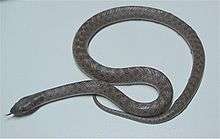Hypsiglena
| Hypsiglena | |
|---|---|
 | |
| Texas night snake Hypsiglena jani texana | |
| Scientific classification | |
| Kingdom: | Animalia |
| Phylum: | Chordata |
| Subphylum: | Vertebrata |
| Class: | Reptilia |
| Order: | Squamata |
| Suborder: | Serpentes |
| Family: | Colubridae |
| Subfamily: | Dipsadinae |
| Genus: | Hypsiglena Cope, 1860 |
 | |
| Synonyms | |
Hypsiglena is a genus of small, rear-fanged, colubrid snakes commonly referred to as night snakes. The genus consists of nine species, and subspecies have been maintained pending further investigation.[2][3]
Species and subspecies
- Hypsiglena affinis Boulenger, 1894 - Boulenger's night snake
- Hypsiglena catalinae W.W. Tanner, 1966 - Santa Catalina night snake
- Hypsiglena chlorophaea Cope, 1860 - Sonoran night snake
- Hypsiglena chlorophaea deserticola W.W. Tanner, 1966 - Desert night snake
- Hypsiglena chlorophaea loreala W.W. Tanner, 1944 - Mesa Verde night snake
- Hypsiglena chlorophaea tiburonensis W.W. Tanner, 1981 - Tiburón Island night snake
- Hypsiglena jani (Dugès, 1865) - Chihuahua night snake
- Hypsiglena jani texana (Stejneger, 1893) - Texas night snake
- Hypsiglena jani dunklei (Taylor, 1938) - Tamaulipas night snake
- Hypsiglena ochrorhyncha Cope, 1860 - Spotted night snake
- Hypsiglena ochrorhyncha baueri Zweifel, 1958 - Cedros Island night snake
- Hypsiglena ochrorhyncha gularis W.W. Tanner, 1954 - Isla Partida night snake
- Hypsiglena ochrorhyncha klauberi W.W. Tanner, 1944 - San Diego night snake
- Hypsiglena ochrorhyncha martinensis W.W. Tanner & Banta 1962 - San Martín Island night snake
- Hypsiglena ochrorhyncha nuchalata W.W. Tanner, 1943 - California night snake
- Hypsiglena ochrorhyncha tortugaensis W.W. Tanner, 1944 - Isla Tortuga night snake
- Hypsiglena ochrorhyncha venusta Mocquard, 1899 - Central Baja night snake
- Hypsiglena slevini W.W.Tanner, 1943 - Baja California night snake
- Hypsiglena tanzeri Dixon & Lieb, 1972 - Tanzer's night snake
- Hypsiglena torquata (Günther, 1860) - Sinaloa night snake
- Hypsiglena unaocularus W.W.Tanner, 1944 - Clarion Island night snake
Geographic range
Hypsiglena are found throughout the southwestern and western United States, from Texas and Kansas, west to California, north to Washington, and south into Mexico, as well as on islands off the coasts of Mexico.
Habitat
Their preferred habitat is semiarid desert regions with rocky and sandy soils.
Description
Night snakes typically do not exceed a total length of 40 cm (16 in). They are slender-bodied with a flattened head, and have small eyes with vertical pupils. Their color varies depending on their locality, often matching the soil color of their native habitat. They occur in various shades of gray, and brown, with dark brown, gray or black blotches on the back and the sides. Many also have distinctive black markings on the neck region.
Behavior
Hypsiglena are nocturnal and terrestrial.
Diet
Their diet consists primarily of lizards, but they will also consume smaller snakes, and amphibians.
Venom
Their venom is not considered to be dangerous to humans.
References
- ↑ Tanner WW. 1944. "A Taxonomic Study of the Genus Hypsiglena ". Great Basin Naturalist 5 (3 & 4): 25-92.
- ↑ Mulcahy, D. G. 2008. Phylogeography and species boundaries of the western North American nightsnake (Hypsiglena torquata): Revisiting the subspecies concept. Molecular Phylogenetics and Evolution 46(3): 1095–1115.
- ↑ Mulcahy, D. G., J. E. Martínez-Gómez, G. Aguirre-León, J. A. Cervantes-Pasqualli, and G. R. Zug. 2014. Rediscovery of an endemic vertebrate from the remote Islas Revillagigedo in the eastern Pacific Ocean: The Clarión Nightsnake, with conservation and systematic implications. PLOS ONE 9(5): e97682.
Further reading
- Cope ED. 1860. "Catalogue of the Colubridæ in the Museum of the Academy of Natural Sciences of Philadelphia, with notes and descriptions of new species. Part 2". Proc. Acad. Nat. Sci. Philadelphia 12: 241-266. (Hypsiglena, p. 246).
External links
- Genus Hypsiglena at The Reptile Database